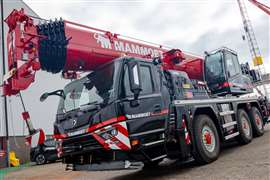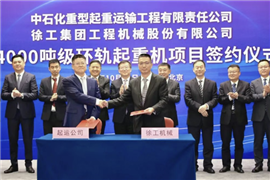Titans of the wind
01 April 2019
Today there are more than 56,800 wind turbines operating in the United States. Chances are high that most of them were erected by just a handful of different crane models.

In the early days of the wind power, industry wind turbines were way lighter and shorter than the huge ones that are going up today. Midsize crawler cranes could often handle them with ease.
But as wind turbines have increased in weights and heights, crane manufacturers have been challenged to produce cranes that can meet these tough erection requirements. Generally, on every wind farm job there is one main crane that performs the erection of the mid and upper sections of a wind tower and then installs the nacelle and blades.
While all the major crawler manufacturers have cranes in their product ranges that can erect smaller wind towers, ACT asked them to identify their “flagship” wind crane, the one that could perform the erection work required of the “main crane.” Following are the three “titans” of the wind industry.
Liebherr LR11000
Liebherr has long been a major player in the global wind market. It’s 400 metric ton capacity LR1400/2 was one of the first lattice boom crawler cranes used to erect wind turbines. From there, Liebherr developed wind attachments for the LR600/2, the LR1750/2, the LG 1750 and the LR11000.

The Liebherr LR11000 can erect any wind turbine up to 120-meter towers without the need of a derrick, Superlift or VPC MAX and any wind turbine up to 160-meter towers.
Later, new jibs like the F2 for the LR1600/2, LR1750/2 and the LR11000 added greater lift capacity and superstructure like the SL8 option increased the ability of the cranes to erect longer boom. And as wind towers have gotten taller and heavier, Liebherr cranes have evolved to meet these requirements.
Today, Liebherr’s flagship wind crane in North America is the LR11000. This crane is particularly suited for wind tower erection for several reasons.
The Liebherr LR11000 can erect any wind turbine up to 120-meter towers without the need of a derrick, Superlift or VPC MAX and any wind turbine up to 160-meter towers, according to Jim Strobush, Liebherr’s North American product manager/national sales manager, crawler cranes.
“This crane has the ability to expand and grow as the wind turbines become taller and heavier without a complete redesign of the crane,” Strobush said. “The LR11000 has the ability to meet the needs of the wind industry in the future. It has low ground bearing pressure due to the very wide track pads of 7 feet 10 inches (2.4 meters).”
Erecting wind towers/turbines requires extremely adept and experienced operators. Strobush said that the LR 11000 was designed to be much simpler to operate because it doesn’t require a derrick or luffing jib attachments.
“The Liccon operating system provides the operator and the lift planner with valuable operating information such as center of gravity and ground bearing pressure,” Strobush said. “It was designed to EN13000 standards, which provides a greater safety margin.”
For the LR11000, the three major wind attachments for North America are the SL3F, with hub heights up to 120 meters. In this configuration the crane is rigged with a 114-meter main boom, and 18-meter jib. The crane has a 179 metric ton capacity, a central ballast (carbody) weight of 90 metric tons and a superstructure weight of 250 metric tons.
In the SL4DFB2 configuration, the LR11000 features hub heights up to 160 meters. The main boom is 156 meters, the fixed jib is 18 meters and the crane has a capacity of 179 metric tons. It has a carbody weight of 50 metric tons, a superstructure weight of 210 metric tons and a derrick counterweight of 450 metric tons.
And finally, the newly developed SL8F2 has hub heights up to 110 meters, a main boom length of 108 meters, a jib length of 18 meters and a capacity of 252 metric tons. The carbody weight is 130 metric tons, the superstructure counterweight is 250 metric tons and the superstructure extension is 80 metric tons.
Terex CC-3800-2
Demag entered the wind industry in a big way in 2003 with the CC 2880-1, according to Ingo Noeske, director of product management, crawler cranes.
Today the company’s premiere wind crane is the Demag CC 3800-1.
“Demag has solutions for the wind industry that provide ease of transport, quick setup and versatility,” Noeske said. “In our crawler range, we offer models that range from 440 tons (400 metric tons) to 3,525 tons (3,200 metric tons) with maximum tip heights from 551 feet (168 meters) to 768 feet (234 meters). Depending on the hub height of the turbine and the weight of rotors and machine house, we a have crane for each job in our crawler range of products.”
The Demag CC 3800-1 is a versatile crane and suited for many job applications, including wind turbine erection, where it has become very popular, Noeske said.
“The CC3800-1 can be equipped with a boom booster system and special LF to be prepared for wind work,” he said. “The maximum hook height without the Superlift system is 383 feet (117 meters) and the capacity is 136 tons (124 metric tons). An assist crane is not required to help erect the main boom.”
When equipped with the Demag Boom Booster kit, the Demag CC 3800-1 can reach a maximum hook height of 570 feet (174 meters) and lift loads up to 88 tons (80 metric tons).
“The Boom Booster kit enables it to handle lifts that would otherwise be the exclusive domain for cranes in the 800-ton class,” Noeske said. “These parameters make the CC 3800-1 especially well-suited to erecting large wind turbines. Our customers appreciate the Demag IC-1 control system that helps keep complex tasks simple. Along with a comfortable cabin that is ergonomically designed, operators are able to configure control elements to their preference. We work with customers to understand their needs in the wind industry – this allows us to offer multiple options for the Boom Booster kit: Superlift mast extension, Split Tray and Flex Frame.”
Noeske said these options, when combined, allow for intelligent counterweight handling. The Split Tray allows for detaching the center counterweight stack and eliminates time, space, lift equipment and manpower for stacking of counterweight. With the Flex Frame the operator can adjust the counterweight radius as required by the lifting configuration. The combination reduces time tower erection, reduces ground bearing pressure and saves time to move from turbine to turbine, he said.
Manitowoc MLC 650
“The market for crawler cranes in the wind industry in North America the past couple years has been positive, and we see it continuing through 2020,” said Harley Smith, global product director for crawler cranes, Manitowoc Cranes. “We have seen high utilization of crawler cranes in North America in the wind market, especially in the larger capacity classes. There is some optimism that the wind market will continue strong beyond the expiration of the PTC (Production Tax Credit), albeit at a slower pace than today.”

With a 3.5-meter-wide boom, the MLC650 has a 717-ton capacity and with the VPC-MAX has a 772-ton capacity.
Manitowoc has two cranes that are particularly suited to the wind market, the MLC300 and MLC650, Smith said.
“The opportunities we have had to serve the North American market, and especially the customers focused in the wind industry, have provided guidance to us as we have further developed our product line,” he explained. “The MLC650 had many core elements of the wind industry in mind during design, and the MLC300 grew into the wind market. And as the wind market has evolved, we have been focused to adapt accordingly.”
The MLC300 has seen work with extended upper boom point for some installations and also served for setting base and mid sections on larger turbines, according to Smith.
“The MLC650 has been utilized in a variety of configurations based on the project conditions and required lifted loads,” Smith said.
Erecting wind towers/turbines requires extremely adept and experienced operators. But Smith said the conversation typically starts with strong charts and fast line speeds.
“Because of conditions at the jobsites, windows for working may be very small,” he said. “Any advantage the crane provides in those windows – or expand them – greatly improve the project timelines. Manitowoc also provides many lift solutions to support the various needs of the projects – whether it be partial breakdowns or wind approvals – to support specific project needs.
The MLC650 has a 717-ton capacity and with the VPC-MAX has a 772-ton capacity. The crane features a 7,227 foot-kips maximum load moment and a 65,962 foot-kips maximum load moment with the VPC-MAX. It has a 341.2-foot B10:680 boom, 479.0-foot B60:680 boom with VPC-MAX, 137.8-foot No. 148 fixed jib on B10:680 boom and a 331.4-foot LJ:681-682 luffing jib on B10:680 boom
The Manitowoc Model 16000 introduction in 2005 was Manitowoc’s major entrance into the wind market.
“Subsequent wind turbine size increases created the need for a stronger boom for the 16000,” Smith said. “It was unique at the time to create a heavy boom that was strong for applications specific to high boom angles. That strategy is far more common amongst manufacturers on larger size crawler cranes. On the Manitowoc MLC300 and MLC650 we have introduced the 3.5-meter-wide boom that elevates the capacities from the standard boom. The application of an extended upper boom point created necessary offset of lifted loads, simplified rigging compared to a jib, and maintains high performance when working in higher wind speeds. This success carried over to our newer developments.”
STAY CONNECTED


Receive the information you need when you need it through our world-leading magazines, newsletters and daily briefings.
CONNECT WITH THE TEAM











